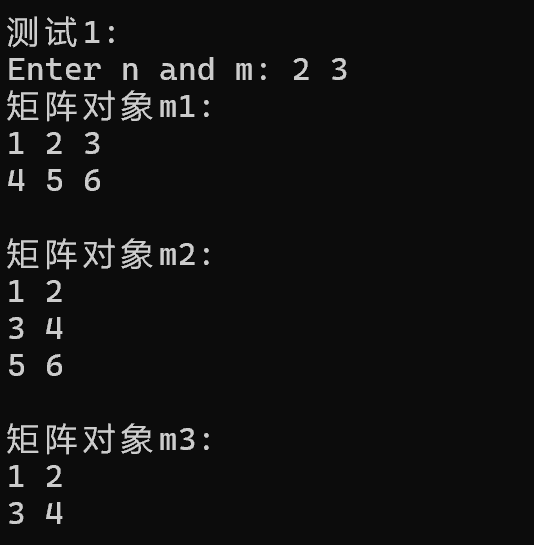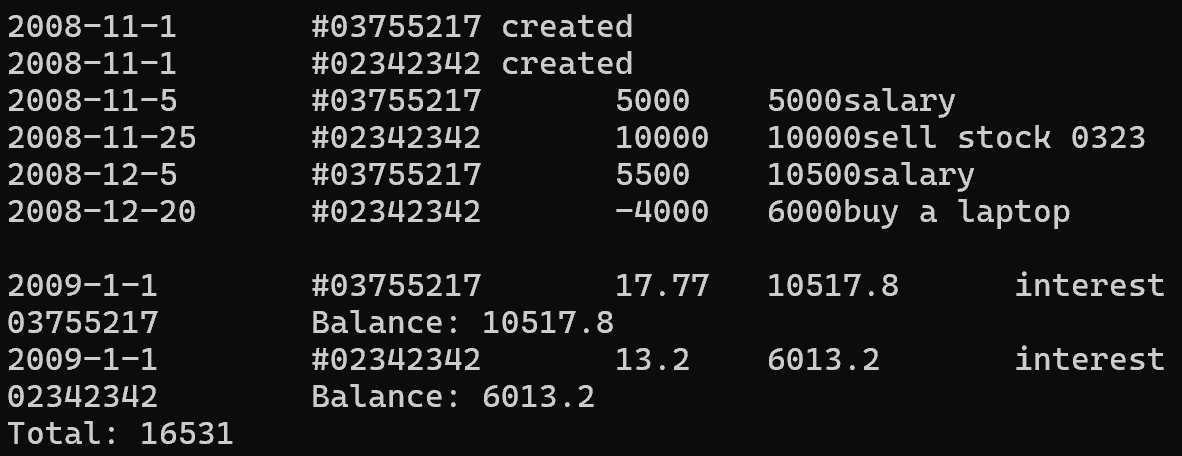实验3 类和对象-基础编程2
实验任务1:
Button.hpp,Window.hpp,task1.cpp,源码,运行测试结果如下

#pragma once #include <iostream> #include <string> using std::string; using std::cout; // 按钮类 class Button { public: Button(const string &text); string get_label() const; void click(); private: string label; }; Button::Button(const string &text): label{text} { } inline string Button::get_label() const { return label; } void Button::click() { cout << "Button '" << label << "' clicked\n"; }

#pragma once #include "button.hpp" #include <vector> #include <iostream> using std::vector; using std::cout; using std::endl; // 窗口类 class Window{ public: Window(const string &win_title); void display() const; void close(); void add_button(const string &label); private: string title; vector<Button> buttons; }; Window::Window(const string &win_title): title{win_title} { buttons.push_back(Button("close")); } inline void Window::display() const { string s(40, '*'); cout << s << endl; cout << "window title: " << title << endl; cout << "It has " << buttons.size() << " buttons: " << endl; for(const auto &i: buttons) cout << i.get_label() << " button" << endl; cout << s << endl; } void Window::close() { cout << "close window '" << title << "'" << endl; buttons.at(0).click(); } void Window::add_button(const string &label) { buttons.push_back(Button(label)); }

#include "window.hpp" #include <iostream> using std::cout; using std::cin; void test() { Window w1("new window"); w1.add_button("maximize"); w1.display(); w1.close(); } int main() { cout << "用组合类模拟简单GUI:\n"; test(); }

问题1:
定义了Button和Window两个类;使用到标准库中的string,vector;sting定义了Button中label且在Window中有输出,vector定义了Window中的Buttons,是一个string的vector
问题2:
click()和close()都没必要加const,因为其没有参数传入;它们也没必要加inline,因为只在开头和结尾使用一次。
问题3:
使用string构造一个字符串,第一个参数是字符串长度int,第二个参数是每个位置应填充的字符;代码将创造含四十个连续*的字符串
实验任务2:
task2.cpp,源码,运行测试结果如下

#include <iostream> #include <vector> using namespace std; void output1(const vector<int> &v) { for(auto &i: v) cout << i << ", "; cout << "\b\b \n"; } void output2(const vector<vector<int>> v) { for(auto &i: v) { for(auto &j: i) cout << j << ", "; cout << "\b\b \n"; } } void test1() { vector<int> v1(5, 42); const vector<int> v2(v1); v1.at(0) = -999; cout << "v1: "; output1(v1); cout << "v2: "; output1(v2); cout << "v1.at(0) = " << v1.at(0) << endl; cout << "v2.at(0) = " << v2.at(0) << endl; } void test2() { vector<vector<int>> v1{{1, 2, 3}, {4, 5, 6, 7}}; const vector<vector<int>> v2(v1); v1.at(0).push_back(-999); cout << "v1: \n"; output2(v1); cout << "v2: \n"; output2(v2); vector<int> t1 = v1.at(0); cout << t1.at(t1.size()-1) << endl; const vector<int> t2 = v2.at(0); cout << t2.at(t2.size()-1) << endl; } int main() { cout << " 1:\n"; test1(); cout << "\n 2:\n"; test2(); }

问题1:
vector<int>v1(5, 42);创造名为v1的一维向量,用五个42填充,const vector<int>v2(v1);创造一个名为v2的一维向量,用v2初始化它,有const修饰不可修改,v1.at(0) = -999;用at成员函数访问v1的第一个元素并将它改为-999
问题2:
vector<vector<int>>v1{ {1,2,3},{4,5,6,7} };创造一个名为v1的二维向量,它包含两个一维向量,分别是{1,2,3}和{4,5,6,7},const vector<vector<int>>v2(v1);创造一个名为v2的二维向量,用v1初始化它,用const修饰不可修改,v1.at(0).push_back(-999);用at成员函数访问v1的第一个一维向量,并向末尾添加-999

#pragma once #include <iostream> #include <cassert> using std::cout; using std::endl; // 动态int数组对象类 class vectorInt{ public: vectorInt(int n); vectorInt(int n, int value); vectorInt(const vectorInt &vi); ~vectorInt(); int& at(int index); const int& at(int index) const; vectorInt& assign(const vectorInt &v); int get_size() const; private: int size; int *ptr; // ptr指向包含size个int的数组 }; vectorInt::vectorInt(int n): size{n}, ptr{new int[size]} { } vectorInt::vectorInt(int n, int value): size{n}, ptr{new int[size]} { for(auto i = 0; i < size; ++i) ptr[i] = value; } vectorInt::vectorInt(const vectorInt &vi): size{vi.size}, ptr{new int[size]} { for(auto i = 0; i < size; ++i) ptr[i] = vi.ptr[i]; } vectorInt::~vectorInt() { delete [] ptr; } const int& vectorInt::at(int index) const { assert(index >= 0 && index < size); return ptr[index]; } int& vectorInt::at(int index) { assert(index >= 0 && index < size); return ptr[index]; } vectorInt& vectorInt::assign(const vectorInt &v) { delete[] ptr; // 释放对象中ptr原来指向的资源 size = v.size; ptr = new int[size]; for(int i = 0; i < size; ++i) ptr[i] = v.ptr[i]; return *this; } int vectorInt::get_size() const { return size; }

#include "vectorInt.hpp" #include <iostream> using std::cin; using std::cout; void output(const vectorInt &vi) { for(auto i = 0; i < vi.get_size(); ++i) cout << vi.at(i) << ", "; cout << "\b\b \n"; } void test1() { int n; cout << "Enter n: "; cin >> n; vectorInt x1(n); for(auto i = 0; i < n; ++i) x1.at(i) = i*i; cout << "x1: "; output(x1); vectorInt x2(n, 42); vectorInt x3(x2); x2.at(0) = -999; cout << "x2: "; output(x2); cout << "x3: "; output(x3); } void test2() { const vectorInt x(5, 42); vectorInt y(10, 0); cout << "y: "; output(y); y.assign(x); cout << "y: "; output(y); cout << "x.at(0) = " << x.at(0) << endl; cout << "y.at(0) = " << y.at(0) << endl; } int main() { cout << "测试1: \n"; test1(); cout << "\n测试2: \n"; test2(); }

问题1:
深复制,因为释放了原有资源并且分配了新内存
问题2:
不能。
如果去掉第一个const,那么返回的引用将不再是对常量的引用,调用者可以通过这个引用来修改整数值。这可能会破坏类的封装性,特别是如果这个函数返回的是类的内部数据结构的直接引用的话。如果去掉第二个const,那么该函数将不再是一个常量成员函数,它将能够修改调用它的对象的状态。这可能会导致在不应该修改对象状态的情况下意外地修改了对象,从而引入难以追踪的错误。
问题3:
不可以?运行结果没有出错,但是返回对象会带来不必要的复制,而且如果错误返回对象的引用会导致未定义行为
实验任务4:
Matrix.hpp,task4.cpp,源码,运行测试结果如下

#pragma once #include <iostream> #include <cassert> using std::cout; using std::endl; // 类Matrix的声明 class Matrix { public: Matrix(int n, int m); // 构造函数,构造一个n*m的矩阵, 初始值为value Matrix(int n); // 构造函数,构造一个n*n的矩阵, 初始值为value Matrix(const Matrix &x); // 复制构造函数, 使用已有的矩阵X构造 ~Matrix(); void set(const double *pvalue); // 用pvalue指向的连续内存块数据按行为矩阵赋值 void clear(); // 把矩阵对象的值置0 const double& at(int i, int j) const; // 返回矩阵对象索引(i,j)的元素const引用 double& at(int i, int j); // 返回矩阵对象索引(i,j)的元素引用 int get_lines() const; // 返回矩阵对象行数 int get_cols() const; // 返回矩阵对象列数 void display() const; // 按行显示矩阵对象元素值 private: int lines; // 矩阵对象内元素行数 int cols; // 矩阵对象内元素列数 double *ptr; };

#include "matrix.hpp" #include <iostream> #include <cassert> using std::cin; using std::cout; using std::endl; const int N = 1000; // 输出矩阵对象索引为index所在行的所有元素 void output(const Matrix &m, int index) { assert(index >= 0 && index < m.get_lines()); for(auto j = 0; j < m.get_cols(); ++j) cout << m.at(index, j) << ", "; cout << "\b\b \n"; } void test1() { double x[1000] = {1, 2, 3, 4, 5, 6, 7, 8, 9}; int n, m; cout << "Enter n and m: "; cin >> n >> m; Matrix m1(n, m); // 创建矩阵对象m1, 大小n×m m1.set(x); // 用一维数组x的值按行为矩阵m1赋值 Matrix m2(m, n); // 创建矩阵对象m1, 大小m×n m2.set(x); // 用一维数组x的值按行为矩阵m1赋值 Matrix m3(2); // 创建一个2×2矩阵对象 m3.set(x); // 用一维数组x的值按行为矩阵m4赋值 cout << "矩阵对象m1: \n"; m1.display(); cout << endl; cout << "矩阵对象m2: \n"; m2.display(); cout << endl; cout << "矩阵对象m3: \n"; m3.display(); cout << endl; } void test2() { Matrix m1(2, 3); m1.clear(); const Matrix m2(m1); m1.at(0, 0) = -999; cout << "m1.at(0, 0) = " << m1.at(0, 0) << endl; cout << "m2.at(0, 0) = " << m2.at(0, 0) << endl; cout << "矩阵对象m1第0行: "; output(m1, 0); cout << "矩阵对象m2第0行: "; output(m2, 0); } int main() { cout << "测试1: \n"; test1(); cout << "测试2: \n"; test2(); }

实验任务5:
user.hpp,task5.cpp,源码,运行测试结果如下

#include<iostream> #include<vector> #include<string> using std::cin; using std::cout; using std::endl; using std::vector; using std::string; class User{ public: User(string n,string p="123456",string e="NULL"); void set_email(); void change_password(); void display() const; private: string name; string password; string email; }; User::User(string n,string p,string e){ name=n; password=p; email=e; } void User::set_email(){ string em; cout<<"Enter email address:"; while(cin>>em){ int count=0; for(int i=0;i<em.size();i++){ if(em[i]=='@'){ count++; } } if(count){ email=em; cout<<"email is set successfully..."<<endl; break; } else{ cout<<"illegal email.Please re-enter email:"; } } } void User::change_password(){ string oe,ne; int count=0; cout<<"Enter old password:"; cin>>oe; for(int i=0;i<3;i++){ if(oe==password){ cout<<"Enter new password:"; cin>>ne; email=ne; cout<<"new password is set succesfully"<<endl; break; } else{ count++; if(count==3){ cout<<"password input error.Please try after a while."<<endl; break; } cout<<"password input error.Please re-enter again:"; cin>>oe; } } } void User::display() const{ cout<<"name:"<<name<<endl; int i=password.size(); for(int j=0;j<i;j++){ cout<<"*"; } cout<<endl; cout<<"email:"<<email<<endl; }

#include "user.hpp" #include <iostream> #include <vector> #include <string> using std::cin; using std::cout; using std::endl; using std::vector; using std::string; void test() { vector<User> user_lst; User u1("Alice", "2024113", "Alice@hotmail.com"); user_lst.push_back(u1); cout << endl; User u2("Bob"); u2.set_email(); u2.change_password(); user_lst.push_back(u2); cout << endl; User u3("Hellen"); u3.set_email(); u3.change_password(); user_lst.push_back(u3); cout << endl; cout << "There are " << user_lst.size() << " users. they are: " << endl; for(auto &i: user_lst) { i.display(); cout << endl; } } int main() { test(); }

实验任务6:
data.hpp,account.cpp,task6.cpp,源码,运行测试结果如下

#pragma once #include <iostream> #include <cstdlib> using namespace std; class Date { private: int year; int month; int day; int totalDays; public: Date(int year, int month, int day); int getYear() const { return year; } int getMonth() const { return month; } int getDay() const { return day; } int getMaxDay() const; bool isLeapYear() const { return year % 4 == 0 && year % 100 != 0 || year % 400 == 0; } void show() const; int distance(const Date& date) const { return totalDays - date.totalDays; } }; namespace { const int DAYS_BEFORE_MONTH[] = { 0, 31, 59, 90, 120, 151, 181, 212, 243, 273, 304, 334, 365 }; } Date::Date(int year, int month, int day) : year(year), month(month), day(day) { if (day <= 0 || day > getMaxDay()) { cout << "Invalid date: "; show(); cout << endl; exit(1); } int years = year - 1; totalDays = years * 365 + years / 4 - years / 100 + years / 400 +DAYS_BEFORE_MONTH[month - 1] + day; if (isLeapYear() && month > 2) totalDays++; } int Date::getMaxDay() const { if (isLeapYear() && month == 2) return 29; else return DAYS_BEFORE_MONTH[month] - DAYS_BEFORE_MONTH[month - 1]; } void Date::show() const { cout << getYear() << "-" << getMonth() << "-" << getDay(); } date.hpp

#pragma once #include "date.hpp" #include <string> #include <cmath> #include <iostream> using namespace std; class SavingsAccount { private: string id; double balance; double rate; Date lastDate; double accumulation; static double total; void record(const Date& date, double amount, const string& desc); void error(const string& msg) const; double accumulate(const Date& date) const { return accumulation + balance * date.distance(lastDate); } public: SavingsAccount(const Date& date, const string& id, double rate); const string& getId() const { return id; } double getRate() const { return rate; } static double getTotal() { return total; } void deposit(const Date& date, double amount, const string& desc); void withdraw(const Date& date, double amount, const string& desc); void settle(const Date& date); void show() const; }; double SavingsAccount::total = 0; SavingsAccount::SavingsAccount(const Date& date, const string& id, double rate) : id(id), balance(0), rate(rate), lastDate(date), accumulation(0) { date.show(); cout << "\t#" << id << " created" << endl; } date, double amount, const string& desc) { accumulation = accumulate(date); lastDate = date; amount = floor(amount * 100 + 0.5) / 100; balance += amount; total += amount; date.show(); cout << "\t#" << id << "\t" << amount << "\t" << balance << "\t" << desc << endl; } void SavingsAccount::error(const string& msg) const { cout << "Error(#" << id << "):" << msg << endl; } void SavingsAccount::deposit(const Date& date, double amount, const string& desc) { record(date, amount, desc); } void SavingsAccount::withdraw(const Date& date, double amount, const string& desc) { if (amount > getBalance()) error("not enough money"); else record(date, -amount, desc); } void SavingsAccount::settle(const Date& date) { double interest = accumulate(date) * rate / date.distance(Date(date.getYear() - 1, 1, 1)); if (interest != 0) record(date, interest, "interest"); accumulation = 0; } void SavingsAccount::show() const { cout << id << "\tBalance: " << balance; }

#include "account.hpp" #include <iostream> using namespace std; int main() { Date date{ 2008, 11, 1 }; SavingsAccount accounts[] = { SavingsAccount(date, "03755217", 0.015), SavingsAccount(date, "02342342", 0.015) }; const int n = sizeof(accounts) / sizeof(SavingsAccount); accounts[0].deposit(Date(2008, 11, 5), 5000, "salary"); accounts[1].deposit(Date(2008, 11, 25), 10000, "sell stock 0323"); accounts[0].deposit(Date(2008, 12, 5), 5500, "salary"); accounts[1].withdraw(Date(2008, 12, 20), 4000, "buy a laptop"); cout << endl; for (int i = 0; i < n; i++) { accounts[i].settle(Date(2009, 1, 1)); accounts[i].show(); cout << endl; } cout << "Total: " << SavingsAccount::getTotal() << endl; return 0; } task6.cpp





